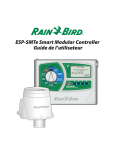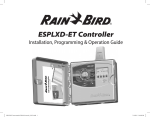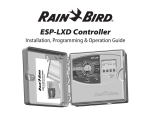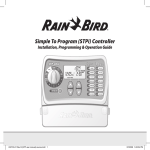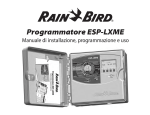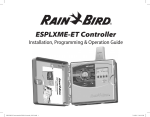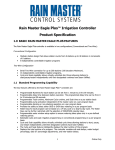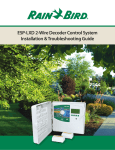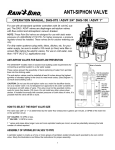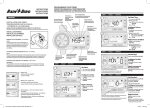Download ESP-LXME Control System FAQ / Troubleshooting Guide
Transcript
ESP-LXME Control System FAQ / Troubleshooting Guide ESP-LXME Control System Diagnostics The ESP-LXME Controller includes diagnostic and status functions to help you troubleshoot and pinpoint the source of the problem. Refer to the ESP-LXME Controller Installation, Programming & Operation Guide (shipped with the controller or available on-line) for step-by-step instructions to use the diagnostic features. Tools and equipment An accurate “as-built” showing wiring and valve locations Filled out ESP-LXME Controller Programming Guide listing valve/station assignments A Volt/Ohm Meter (multi-meter) capable of reading 0 to 50 volts AC and resistance from 0 to 1,000,000 Ohms Wire tracing and fault finding equipment Spare system components and tools including: spare valve solenoids, 3M DBR/Y-6 wire splice kits, wire strippers ESP-LXME output voltage The ESP-LXME has an output voltage of 26.5 VAC Types of field wiring issues Open wire circuit Short circuit Ground fault Note: A majority of field wiring issues are caused by poor wire splices! Use only 3M DBR/Y-6 Wire Splice Kits. All splices should be made in splice boxes. Open circuit You will notice one or more stations are not running even though they are programmed to operate. If the system is using flow sensing, you will receive a low (zero) flow alarm for each station. - Use Test All Stations function to check which stations are operating (available in Manual Watering and Test All Stations / Check System dial positions. Controller diagnostics - Turn dial to Test All Stations / Check System; Select Raster Wiring Test. The test results will indicate any station (or MV) that has a problem. Only stations with station run times programmed will be included in the test. - Stations or MV that report Open Circuit do not have a complete wire circuit between the controller module and the valve. The wire circuit is comprised of the hot wire for each station/valve (wire connected to the station module terminal and the first valve solenoid 2 ESP-LXME Control System FAQ / Troubleshooting Guide wire) and the field common wire (wire connected to the common wire terminal and the second valve solenoid wire). The common wire interconnects the second valve solenoid wires of each valve and MV in the system. - If all stations and MV show Open Circuit, the problem is likely on the common wire. - If only one or a few stations show Open Circuit, the problem is likely with those station wires. Field wiring diagnostics - Use a Volt/Ohm Meter set to VAC to check the voltage at the solenoid of the problem valve. When the valve is turned on, the voltage should read 26.5 VAC minus the line loss over the length of the valve and common wires. 24 VAC is optimal. - A solenoid damaged by a lightning power surge or overheating can fail in either an open or closed coil condition. Use a Volt/Ohm Meter set to Ohms resistance to check if the solenoid coil is open. If it is, replace the solenoid. Short circuit You will notice the controller alarm light is illuminated and the alarm screen shows one or more stations with a Short Detected - Clear the short alarm(s) by following the instructions on the alarm screen and manually operate the station(s) to verify the issue - Use Test All Stations function to check which stations are operating (available in Manual Watering and Test All Stations / Check System dial positions). Controller diagnostics - Turn dial to Test All Stations / Check System; Select Raster Wiring Test. The test results will indicate any station (or MV) that has a problem. Only stations with station run times programmed will be included in the test. - Stations or MV that report a Short Circuit have a short between the controller the station hot wire (wire connected to the station module terminal and the first valve solenoid wire) and the field common wire (wire connected to the common wire terminal and the second valve solenoid wire). Or the solenoid has been damaged and is shorted. Field wiring diagnostics - Disconnect the valve power and common wires from the solenoid. Use a Volt/Ohm Meter set to VAC to check the voltage at the solenoid of the problem valve. The voltage should read 26.5 VAC minus the line loss over the length of the valve and common wires. 24 VAC is optimal. If the voltage is too low the solenoid will not open the valve. - A solenoid damaged by a lightning power surge or overheating can fail in either an open or closed coil condition. Use a Volt/Ohm Meter set to Ohms Resistance to check if the solenoid coil is open. If it is, replace the solenoid. ESP-LXME Control System FAQ / Troubleshooting Guide 3 ESP-LXME Control System Troubleshooting Consult the ESP-LXME Controller Installation, Programming & Operation Guide (shipped with the controller or available on-line) for detailed information on the built-in diagnostic features of the controller. Section A / Auto – The controller displays the current status of the system along with any alarm conditions in the Auto dial position. Section C / Systems Diagnostics – System diagnostic and troubleshooting tools are available in the Test All Station / Check System dial position. Troubleshooting 4 Category Issue Potential Cause Solution Controller Notifications Controller Notification; Module Configuration Change Detected. A station module has been added, removed, or can no longer communicate with the controller front panel. Press Next in the notification screen to view the changes detected. If you have just added a new module review the new station numbering and press Accept. If you just removed a module review the new station numbering and press accept. If you have not made a module change review the changes screen to see what has changed. If a module can no longer communicate with the controller front panel, remove it and then reinstall it. The module status light should illuminate then go dark when it communicates with the front panel. If it cannot communicate with the front module, the module status light will blink continuously. Press Reject to reject the module configuration change and replace the module. Controller Alarms Red alarm light on the controller front panel is illuminated. The controller is reporting an alarm condition. Turn dial to Auto, press the Alarm button, review the alarm conditions, and address the issue(s). Controller alarm; No Base Module. The module in module slot 0 is not properly attached to the controller module slot. Remove and reinstall the module making sure it is fully seated in the module slot. The module status light should illuminate red when the module is inserted in the module slot then go dark after it communicates with the front panel. Controller alarm; No Station Modules. The module(s) are not properly attached to the controller module slot(s). Remove and reinstall the module(s) making sure it is fully seated in the module slot. The module status light should illuminate red when the module is inserted in the module slot then go dark after it communicates with the front panel. Controller alarm; Valve Shorts "Station XX" Short (or MV). Shorted valve wire or solenoid. The status light on the module of the shorted station will blink continuously. Remove the shorted station wire from the module. In the Auto dial position select Alarm and Clear. Manually start the problem station. If the short is in the field (wiring or solenoid) the station will operate without posting a new alarm. Identify and resolve the field issue and reconnect the station wire. If after disconnecting the station wire, clearing the Alarm, and manually starting the station the Alarm is posted again the short is in the station module. Replace the module and test again. ESP-LXME Control System FAQ / Troubleshooting Guide Troubleshooting Category Issue Potential Cause Solution Controller Alarms Controller alarm; Zero Learned Flow. While executing the Learn Flow Utility, the controller has recorded a zero (0) flow rate for one or more station. Turn dial to Flow and Smart Module - Module Status, select Flow Smart Module, View Flow Rates, View Station Rates. Check for stations that have a 0 flow rate and are labeled Learned. - If all stations have learned a 0 flow check flow sensor/ input connections, Flow Sensor configuration, FloZone assignment, etc. - If only one or a few stations have learned a 0 flow rate check the valve operation (flow control stem position, solenoid, wiring, etc.). - If just small flow rate valves/stations (like drip zones) have learned a 0 flow rate the flow sensor may be too large for the lower flow rates. Check the product technical specs for the minimum flow rate of the flow sensor. Controller alarm; Flow Alarm. FloWatch (flow sensing utility) has detected a high or low flow condition. Turn dial to Flow and Smart Module - Module Status, select Flow Smart Module, View Flow Alarms, and review the posted Station and/or Mainline flow alarms. Note the station(s) that were identified. If you configured FloWatch to Diagnose & Eliminate or Alarm & Shut Down, the problem station(s) or water source (mainline) will be quarantined. Clear the Flow Alarms and test the system. - Station flow alarms – Manually turn on the station. Turn dial to Module Status, select Flow Smart Module, View Current Flow. The current and expected flow rates will be listed. Check the valve & sprinklers to identify the issue and correct it. If sprinklers or nozzles have been replaced, relearn the station flow rate. - FloZone alarms - Manually start a program. Turn dial to Module Status, select Flow Smart Module, View Current Flow. The current and expected flow rates will be listed. Check the water source(s) and mainline to identify the issues and correct it. - If FloZone high flow alarms are being triggered by manual watering (QCV, manually bleeding valves, etc.) consider using the MV Water Window located under the Manual Watering dial position. Configure window open and close times, days of the week, MV(s) you want open, and the expected additional flow rate to allow for the manual watering. Controller Alarms Controller alarm; Invalid Module Config. A non-compatible module has been inserted into one of the controller module slots. ESP-LXME Control System FAQ / Troubleshooting Guide Remove any recently added modules, one at a time, until the alarm condition clears. - ESP-LXD Decoder or IQCMLXD Connection Modules are not compatible. 5 Troubleshooting Category Issue Potential Cause Solution Controller Alarms Controller alarm; No PGM will Auto Run. Incomplete programming. Turn dial to Test All Stations / Check System, select Confirm Programs, Program Summary. Missing programming parameters are identified by an N. For programs to automatically run you need to program Start Days, Start Times, and Station Run Times. Controller Alarm; No Power – Irrigation Functions are Disabled. No primary power to the controller transformer Check the power input to the controller transformer. The display is being powered by the 9v backup battery. Front panel ribbon cable is disconnected Check both ends of the ribbon cable to make sure it is firmly connected to the backplane and front panel. Programs are running at random times. Multiple start times have been programmed unintentionally. Turn dial to Test All Stations / Check System and select Confirm Programs then Review Program. Review each program using the Program slide switch to select the program. Check for multiple start times on an individual program. In some cases users mix-up start times and stations and can inadvertently program the system to start multiple times per day. Water Windows have been configured so programs are paused and resume later. Turn dial to Delay Watering and select Water Window. Use the Programs slide switch to select a program (ABCD). Water Windows control the hours of the day a program is allowed to operate. If a program starts outside a Water Window it is paused until the window opens. If the program is still running when the Water Window closes the program is paused and will automatically start the next time the window opens. Adjust the Water Window open and close times to allow the program to complete. Programs 6 Station Sequencing Stations are not running in station number sequence Station Sequencing set to Sequence by Station Priority The ESP-LXME offers 2 station sequencing modes: • Sequence by Station Numbers (default) – Station selection criteria: a) Non-Irrigation Priority; b) Station number low to high; c) Program assignment ABCD. • Sequence by Station Priority (automatically used if FloManager is On) Station selection criteria: a) Station Priority Non-Irrigation, High, Medium, Low; b) Station Run Time longest to shortest; c) Station number low to high; d) Program Assignment ABCD. To change Station Sequencing mode turn dial to Advanced Settings and select Station Sequencing. Use the +/- softkeys to change the selection. Station Valves A station valve is not operating. Valve is manually closed or solenoid is damaged. Turn dial to Manual Watering and select Start Station. Select the station making sure it has a run time and press run. Check to see if the valve is operating and if it isn't address the valve issue. Station does not have run time for a program with start days and a start time. Turn dial to Test All Stations / Check System and select Station Run Time. Note which programs the station has run times programmed. Use Program Summary to make sure that program has start days and start times. ESP-LXME Control System FAQ / Troubleshooting Guide Troubleshooting Category Issue Potential Cause Solution Station Valves A station valve is not operating. Valve wires are not spliced correctly. Turn dial to Test All Stations / Check System and select Raster Wiring Test. The Raster Test will check the output of the MV and each station that has programmed station run time. The results of the test will identify stations with shorts or open circuits. Identify and fix the field issues. Master Valves The Master Valve will not open when stations are operating. MV is Normally Open but has been configured as a Normally Closed MV. If the MV valve is Normally Open (powered to close) it needs to be configured as Normally Open. Turn dial to Setup Wizards, select MV Setup. Change MV from Normally Closed (default) to Normally Open. Station not configured to open Master Valve. Go to Station/MV Settings, Station Settings to make sure the station is configured as requiring a Master Valve. No input from the flow sensor. Flow sensor wiring polarity is reversed. The FS-Series Flow Sensors have red and black wires that must connect to the Flow +/- terminals on the module as follows; Red wire to the red flow + terminal and black wire to the grey flow - terminal. When the flow sensor is configured correctly and connected with the correct polarity a blue light on the module will blink to the rate of the system flow. Continuous flow rate is displayed even when the system is off. Flow sensor wiring is shorted or grounded. If the flow sensor wiring is shorted or grounded the blue light on the module will blink continuously. Remove the flow sensor wire and the module. Reinstall the module and the flow rate should return to 0. If secondary surge protection was installed remove it. Find and fix the wiring issue, reconnect the flow sensor wires, and test the system. Pump Start Relays The controller MV cannot close the relay on a pump start relay to operate a pump. Amp draw of the pump start relay is more than the MV can provide. Use a Rain Bird PSR-Series Pump Start Relay that incorporates an ice-cube relay, double relay system. You can also add an ice-cube relay to an existing pump start relay. Contact Rain Bird Technical Services or Global Support Plan for relay model and wiring diagram. Controller LCD Display The controller display is either too light or too dark. The display contrast needs to be adjusted. Turn dial to Off, press Contrast +/- buttons to adjust display contrast. Controller display is blank. Controller LCD display is damaged. Plug in a 9V battery into the battery slot on the back of the controller front panel. If information is now visible on the display it is not damaged and working correctly. See other potential causes. If no information is displayed, remove the base module. If the alarm light on the front panel turns on after 1 minute but no information is in the display, the LCD is damaged and the front panel should be replaced. Controller display is blank. Primary power to the controller has been lost or turned off. This can be verified by checking the a module status light by removing and reinstalling a station module. If the module status light never turns on then the primary power is likely off. Find primary power source to the controller and turn it on. If the power breaker is tripped or fuse is blown, find source of problem, fix the issue, and turn the power back on. FSMLXME Flow Smart Module Controller LCD Display ESP-LXME Control System FAQ / Troubleshooting Guide 7 Troubleshooting Category Issue Potential Cause Solution Controller LCD Display Controller display is blank. Controller ribbon cable is not connected or damaged. Check to make sure the ribbon cable is securely connected to both the controller backplane and the front panel. If the cable has broken wires or connectors, replace it. SimulStations (Simultaneous Station Operation) Too many or too few stations are operating simultaneously when program(s) operate. LXME (Controller) SimulStations are configured incorrectly. Turn dial to Advanced Settings and select SimulStations. Select Lame SimulStations and adjust the maximum number of simultaneous irrigation stations you want to allow to operate across all programs at any time. NonIrrigation SimulStations control stations with Non-Irr Priority. PGM (Program) SimulStations are configured incorrectly. Turn dial to Station Settings and select SimulStations. Select PGM SimulStations and adjust the maximum number of simultaneous irrigation stations you want to allow to operate simultaneously within the currently selected program. Move the Program slide switch to select the other programs (ABCD). Only 2 stations per station module can operate simultaneously. The maximum number of simultaneous stations: - 1 module installed = 2 stations - 2 modules installed = 4 stations - 3 modules installed = 5 stations - 4 modules installed = 5 stations If a normally closed MV is used the maximum number of simultaneous stations possible is 4. Weather sensor is not preventing controller manual operation. This is by design. Manual station, program or test program operation (from the front panel or a remote) is allowed regardless of the weather sensor state. To see the current state of a weather sensor, turn the dial to Test All Stations / Check System and select Wthr Sensor Status. The status of each sensor is displayed. Wireless weather sensor is not providing input to the controller. Sensor receiver is not wired to the controller module correctly. The Base Modules include 4 terminals for wireless weather sensor connections. Wiring connections should be made as follows: • Sensor receiver power wires to COM and 24V terminals. • Sensor receiver sensor wires to the 2 SEN terminals. I am having trouble removing the knockouts on the ESP-LX Series Controller plastic cabinet. Unlike knock-outs on a metal enclosure, these plastic knock-outs are designed to be removed by applying force to the center at the dimple. Prior to installing the cabinet, place on a flat surface with the knock-out facing up. Locate the dimple in the center of the knock-out you wish to remove. Place the tip of a large Phillips screwdriver in the dimple. Use a rubber or wooden mallet to firmly strike the top of the screwdriver. The knockout should pop out in a single piece. If it breaks, use pliers to remove the pieces. Do not use a flat-bladed screwdriver around the outside of the knock-out as this could crack the case. Weather Sensors Controller Knock-outs 8 ESP-LXME Control System FAQ / Troubleshooting Guide The Intelligent Use of Water.™ LEADERSHIP • EDUCATION • PARTNERSHIPS • PRODUCTS At Rain Bird, we believe it is our responsibility to develop products and technologies that use water efficiently. Our commitment also extends to education, training and services for our industry and our communities. The need to conserve water has never been greater. We want to do even more, and with your help, we can. Visit www.rainbird.com for more information about The Intelligent Use of Water.™ For questions regarding the products in this guide contact: For training on the products in this guide contact: Rain Bird Corporation 6991 East Southpoint Road Tucson, AZ 85756 Phone: (520) 741-6100 Fax: (520) 741-6522 Rain Bird Services Corporation 6991 E. Southpoint Rd. Tucson, AZ 85756 Toll Free: (800) 498-1942 Fax: (520) 741-6168 www.rainbird.com www.rainbirdservicescorporation.com ® Registered Trademark of Rain Bird Corporation © 2013 Rain Bird Services Corporation 10/13 D40571












